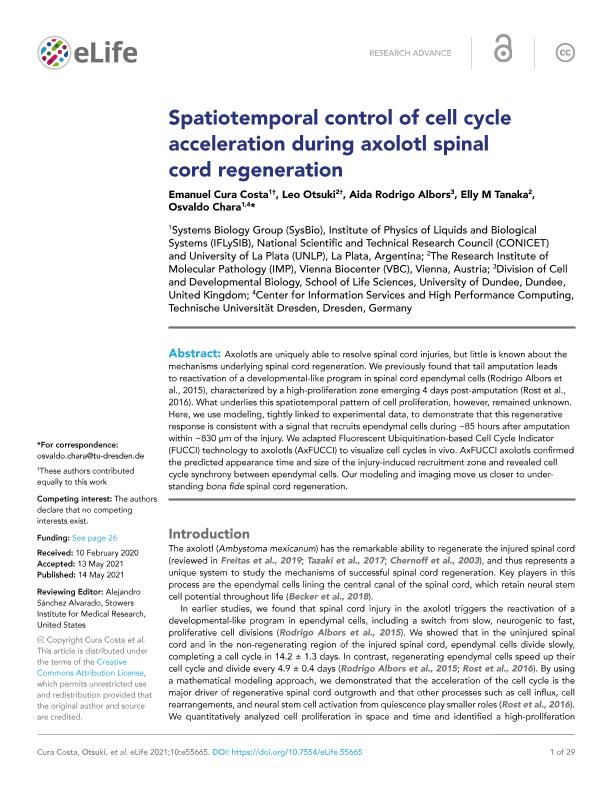Artículo
Spatiotemporal control of cell cycle acceleration during axolotl spinal cord regeneration
Fecha de publicación:
05/2021
Editorial:
eLife Sciences Publications
Revista:
eLife
ISSN:
2050-084X
Idioma:
Inglés
Tipo de recurso:
Artículo publicado
Clasificación temática:
Resumen
Axolotls are uniquely able to resolve spinal cord injuries, but little is known about the mechanisms underlying spinal cord regeneration. We previously found that tail amputation leads to reactivation of a developmental-like program in spinal cord ependymal cells (Rodrigo Albors et al., 2015), characterized by a high-proliferation zone emerging 4 days post-amputation (Rost et al., 2016). What underlies this spatiotemporal pattern of cell proliferation, however, remained unknown. Here, we use modeling, tightly linked to experimental data, to demonstrate that this regenerative response is consistent with a signal that recruits ependymal cells during ~85 hours after amputation within ~830 μm of the injury. We adapted Fluorescent Ubiquitination-based Cell Cycle Indicator (FUCCI) technology to axolotls (AxFUCCI) to visualize cell cycles in vivo. AxFUCCI axolotls confirmed the predicted appearance time and size of the injury-induced recruitment zone and revealed cell cycle synchrony between ependymal cells. Our modeling and imaging move us closer to understanding bona fide spinal cord regeneration.
Palabras clave:
REGENERATION
,
AXOLOTL
,
SPINAL CORD
,
MATHEMATICAL MODEL
Archivos asociados
Licencia
Identificadores
Colecciones
Articulos(IFLYSIB)
Articulos de INST.FISICA DE LIQUIDOS Y SIST.BIOLOGICOS (I)
Articulos de INST.FISICA DE LIQUIDOS Y SIST.BIOLOGICOS (I)
Citación
Cura Costa, Emanuel; Otsuki, Leo; Albors, Aida Rodrigo; Tanaka, Elly M.; Chara, Osvaldo; Spatiotemporal control of cell cycle acceleration during axolotl spinal cord regeneration; eLife Sciences Publications; eLife; 10; 5-2021; 1-29
Compartir
Altmétricas




